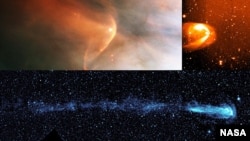If you've ever seen a speeding comet or even an image of one, you've seen that it has a tail. Scientists have thought that our solar system also has a tail, but they just observed it for the first time.
Interstellar Boundary Explorer
NASA's Interstellar Boundary Explorer, or IBEX, is a satellite that peers out toward the edge of our solar system. It allowed scientists to actually map out the tail of our heliosphere, that region of space that is influenced by the Sun.
Eric Christian, an IBEX mission scientist at NASA's Goddard Space Flight Center in Maryland, said scientists have seen tails around other stars.
"We know that the Sun is moving relative to interstellar gas, and so we presumed there was a tail, but this is actually the first real data that we have that gives us the shape of the tail," he said in a NASA-organized Google Plus Hangout Wednesday.
Clover Shaped
Scientists say the tail resembles a four-leaf clover, shaped by solar wind, the material that speeds away from the sun. Solar wind travels faster when it comes from the sun's poles, and slower when it comes from the equator, and scientists attribute the tail's shape to the combination of slow and fast moving particles.
Tail's Length
David McComas, an assistant vice president for space science and engineering at the Southwest Research Institute in Texas, is the IBEX principal investigator.
"The length of the tail is one of the things we don't measure particularly well," he said, noting that the measurements are taken from inside the heliosphere looking out.
But McComas says scientists can make calculations based on the particles they observe, and they think the heliotail trails off and evaporates over a distance of possibly 160 billion kilometers.
The findings about the solar system's tail were published in the July 10 issue of the Astrophysical Journal.
Interstellar Explorer
NASA's IBEX spacecraft was launched in 2008, and the small satellite is roughly the size of a bus tire. It has instruments similar to telescopes that are pointed toward the edge of our solar system. These instruments collect particles that travel toward our planet from out beyond Pluto.
Scientists analyze details about the particles' mass and energy, as well as the area they came from and the time they were collected, and they use these details to map the boundary of our solar system.
Interstellar Boundary Explorer
NASA's Interstellar Boundary Explorer, or IBEX, is a satellite that peers out toward the edge of our solar system. It allowed scientists to actually map out the tail of our heliosphere, that region of space that is influenced by the Sun.
Eric Christian, an IBEX mission scientist at NASA's Goddard Space Flight Center in Maryland, said scientists have seen tails around other stars.
"We know that the Sun is moving relative to interstellar gas, and so we presumed there was a tail, but this is actually the first real data that we have that gives us the shape of the tail," he said in a NASA-organized Google Plus Hangout Wednesday.
Clover Shaped
Scientists say the tail resembles a four-leaf clover, shaped by solar wind, the material that speeds away from the sun. Solar wind travels faster when it comes from the sun's poles, and slower when it comes from the equator, and scientists attribute the tail's shape to the combination of slow and fast moving particles.
Tail's Length
David McComas, an assistant vice president for space science and engineering at the Southwest Research Institute in Texas, is the IBEX principal investigator.
"The length of the tail is one of the things we don't measure particularly well," he said, noting that the measurements are taken from inside the heliosphere looking out.
But McComas says scientists can make calculations based on the particles they observe, and they think the heliotail trails off and evaporates over a distance of possibly 160 billion kilometers.
The findings about the solar system's tail were published in the July 10 issue of the Astrophysical Journal.
Interstellar Explorer
NASA's IBEX spacecraft was launched in 2008, and the small satellite is roughly the size of a bus tire. It has instruments similar to telescopes that are pointed toward the edge of our solar system. These instruments collect particles that travel toward our planet from out beyond Pluto.
Scientists analyze details about the particles' mass and energy, as well as the area they came from and the time they were collected, and they use these details to map the boundary of our solar system.







